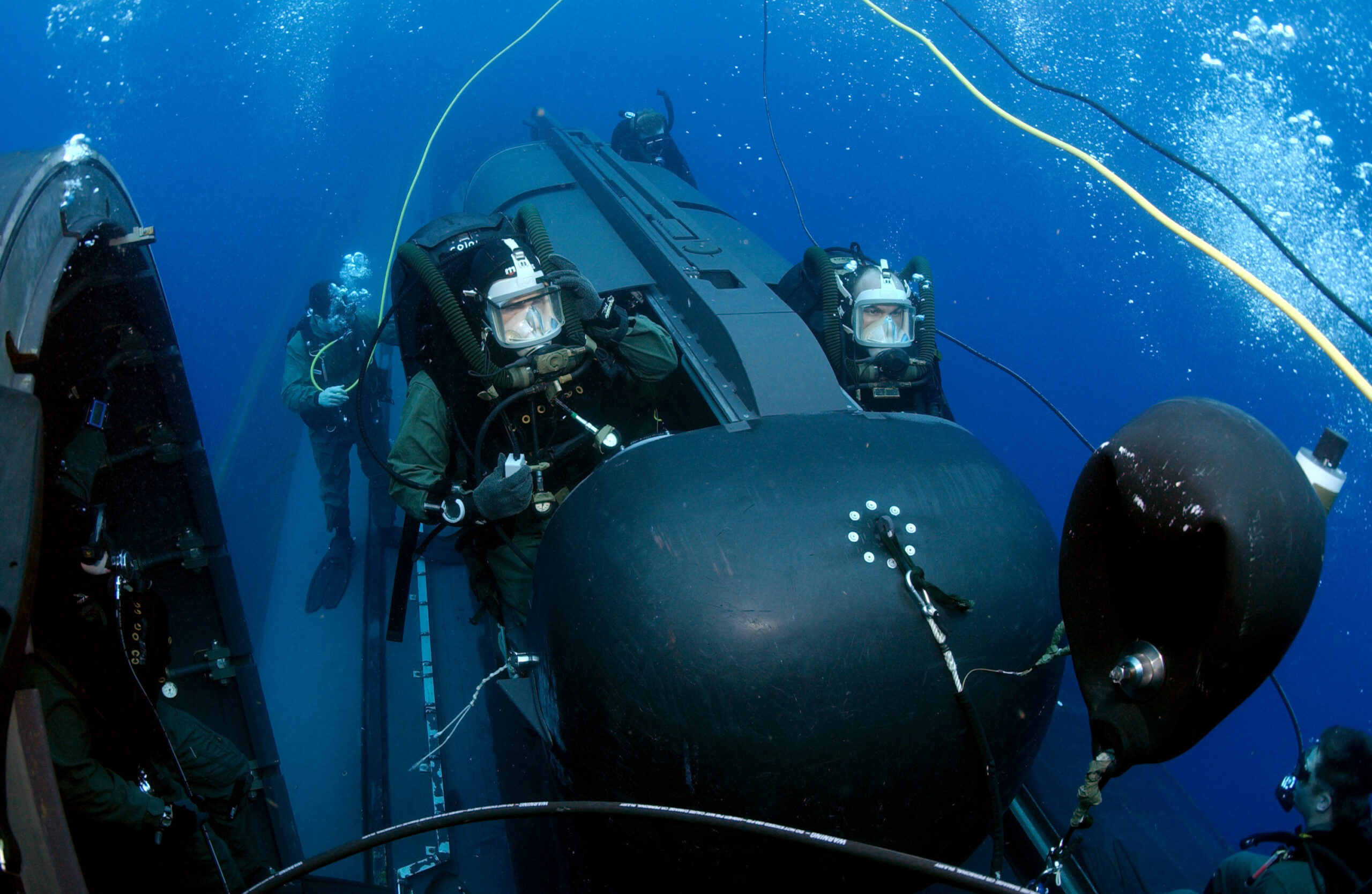Members of SEAL Delivery Vehicle Team Two (SDVT-2) prepare to launch one of the team’s SEAL Delivery Vehicles (SDV) from the back of the Los Angeles-class attack submarine USS Philadelphia (SSN 690) on a training exercise. Naval Special Warfare traces its lineage to the OSS Maritime Unit, as well as the Navy Underwater Demolition Teams (UDT) created during World War II. US Navy photo by Chief Photographer’s Mate Andrew McKaskle (RELEASED)
Dr. Christian James Lambertsen was an American environmental medicine and diving medicine specialist who played a pivotal role in the development of scuba diving. His contributions to the field of diving medicine and his service in the Office of Strategic Service (OSS) during World War II have left a lasting impact on both military and recreational diving.
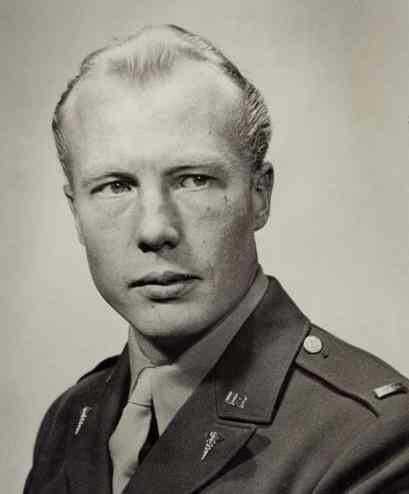
Born May 15, 1917, in Westfield, New Jersey, Lambertsen was raised in Scotch Plains, New Jersey. He graduated from Scotch Plains-Fanwood High School in 1935 and later attended Rutgers University in New Brunswick, New Jersey, graduating in 1939 with a Bachelor of Science degree. Lambertsen furthered his education at the University of Pennsylvania Medical School, Philadelphia, Pennsylvania, graduating in 1943.
Father of the Frogmen
Lambertsen served in the US Army Medical Corps from 1944 to 1946. During this time, he invented and demonstrated a self-contained oxygen rebreathing system to the OSS. The OSS, impressed by the concept, hired Major Lambertsen to lead the program and build-up the dive element of their maritime unit. He was instrumental in establishing the first cadres of US military operational combat swimmers during late World War II.
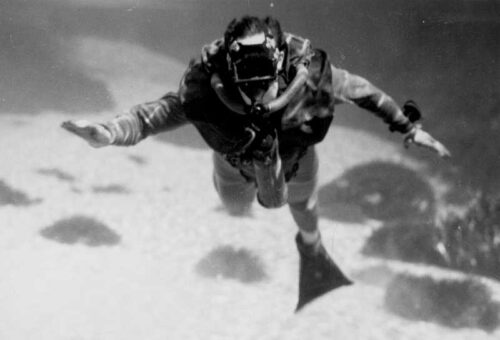
The history of diving is closely linked with the history of the equipment. By the turn of the twentieth century, two basic architectures for underwater breathing apparatus had been pioneered; open-circuit surface supplied equipment where the diver’s exhaled gas is vented directly into the water, and closed-circuit breathing apparatus or rebreathers where the diver’s carbon dioxide is filtered from the exhaled breathing gas, which is then recirculated, and more oxygen added to replenish the oxygen content.
The first commercially practical rebreather was designed and built by the diving engineer Henry Fleuss in 1878. However, it was Lambertsen’s invention during World War II that revolutionized the field. Although not the only military rebreather in service at the time, his rebreather system was developed specifically for underwater warfare. It provided divers with unprecedented freedom and mobility underwater, helping to pave the way for modern diving.
Lambertsen designed a series of rebreathers in 1940 (patent filing date: December 16, 1940) and in 1944 (patent issue date: May 2, 1944), initially calling his invention simply a breathing apparatus. After the war, he renamed it LARU (an acronym for Lambertsen Amphibious Respiratory Unit) and finally, in 1952, he changed the name again to SCUBA (an acronym for Self-Contained Underwater Breathing Apparatus). The US Navy considers Lambertsen to be the “Father of the Frogmen”. Ironically, Lambertsen had originally wanted to join the Navy, but they disqualified him because of his allergies.
With the aid of a LARU, a diver had the capability to navigate underwater at a depth of 50 feet for a duration of 90 minutes. This provided sufficient time to cover a distance close to a mile. As it was a closed-circuit breathing apparatus, it left no bubbles, making it ideally suited for clandestine missions. The LARU underwent subsequent enhancements and adaptations, and its technology was incorporated by the US Army, US Navy, and NASA.
The Office of Strategic Services (OSS)
The OSS was the intelligence agency of the United States during World War II. Formed as an agency of the Joint Chiefs of Staff (JCS), the OSS coordinated espionage activities behind enemy lines for all branches of the US Armed Forces. Other OSS functions included the use of propaganda, subversion, and post-war planning. The OSS was dissolved a month after the end of the war, and its intelligence tasks were shortly later resumed and carried over by its successors, the Department of State’s Bureau of Intelligence and Research (INR) and the independent Central Intelligence Agency (CIA).
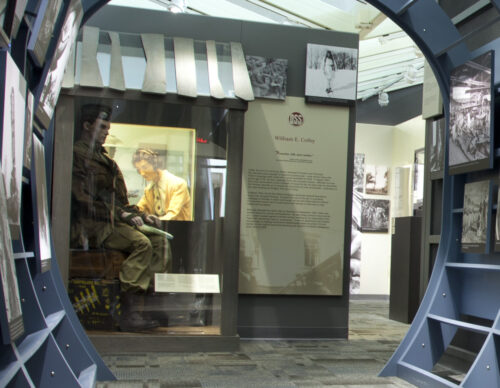
OSS Maritime Unit
Lambertsen was selected by the OSS to spearhead the development of the diving component of its Maritime unit (MU), a responsibility he embraced with enthusiasm. Despite being in the midst of his medical studies, he conducted his inaugural class for the OSS Operational Swimmer Groups (OSG) in May 1943, at the Naval Academy situated in Annapolis, Maryland.
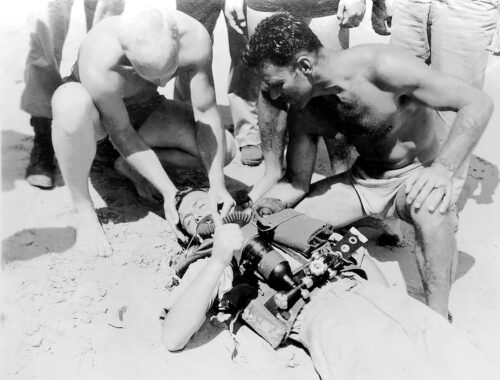
The OSS Maritime Unit was established during a time when the OSS was tasked with two primary missions: to collect, analyze, and disseminate foreign intelligence, and to conduct unconventional warfare. The Maritime Unit was specifically designed to conduct amphibious infiltrations, underwater sabotage, agent infiltrations, and to supply resistance groups by sea. They were also tasked with developing specialized maritime equipment and devices. The OSS Maritime Unit laid a foundation for today’s maritime special operations units.
The OSS Maritime Unit was a trailblazer in special operations. It not only served as an early force in maritime warfare but also developed and utilized innovative equipment and devices. The OSS Maritime Unit specialized in over-the-beach (OTB) operations, utilizing cutting-edge swimming fins, masks, and underwater rebreathing units, allowing for stealth. Its innovations also included an inflatable surfboard, a two-person kayak, and limpet mines to be attached to the hulls of ships.
Their operations were not limited to any specific theater of war. In the Mediterranean, they covertly backed OSS agents in Albania, Greece, and Yugoslavia using a fleet of Greek wooden fishing vessels, known as caiques. Following Italy’s capitulation, the Maritime Unit collaborated with the San Marco battalion, a distinguished Italian naval special operations unit, to launch operations against the Germans. In the Far East, the Maritime Unit joined forces with an Operational Group to confront Japanese forces on Burma’s Arakan coast. They jointly undertook reconnaissance missions along the Japanese-controlled coast, occasionally venturing several miles up rivers under enemy control. OSS-led guerrillas, 10,000 Kachin tribesmen, helped undermine Japanese control in Burma, and the OSS established contact with other resistance movements in Thailand and Indochina.
The origins of the US Navy SEALs can be traced back to the OSS Maritime Units. The capabilities developed and honed by these units were inherited and continue to be integral to the operations of today’s SEAL Teams. The roots of the Army Special Forces Underwater Operations School in Key West, Florida, which serves as the hub for Special Forces maritime operations, can be also traced back to the Maritime Unit, as can the CIA’s Maritime Branch.
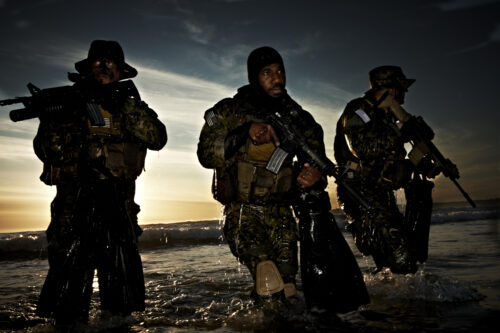
US Navy Underwater Demolition Teams
Although the OSS Maritime Unit and the US Navy Underwater Demolition Teams (UDT) were both established during World War II, they had different missions and capabilities.
The OSS Maritime Unit was a joint-service maritime component of the OSS. Its mission was to conduct amphibious infiltrations, underwater sabotage, agent infiltrations, and to supply resistance groups by sea. They were also tasked with developing specialized maritime equipment and devices.
The UDTs, or “frogmen,” were amphibious units created by the US Navy. Their primary function during the war began with reconnaissance and underwater demolition of natural or man-made obstacles obstructing amphibious landings¹. Postwar they transitioned to scuba gear changing their capabilities. With that they came to be considered more elite and tactical during the Korean and Vietnam Wars. UDTs were pioneers in underwater demolition, closed-circuit diving, combat swimming, and midget submarine (dry and wet submersible) operations.
In 1961, President John F. Kennedy issued a call for the expansion of special forces trained specifically for unconventional warfare. As a result, in 1962, the Navy established the first two SEAL teams, drawing personnel from the existing UDTs. In 1983, the remaining UDTs were re-designated as SEAL Teams or Swimmer Delivery Vehicle Teams (SDVTs) after undergoing additional SEAL training. SDVTs have since been re-designated SEAL Delivery Vehicle Teams.
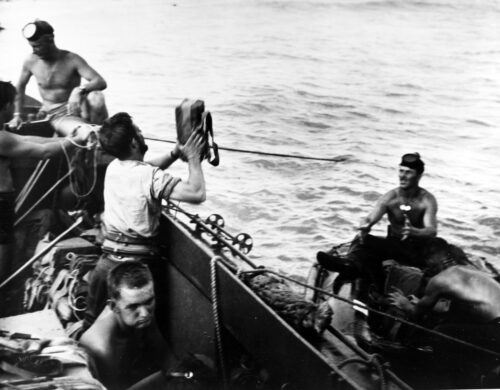
Summary
Dr. Christian Lambertsen’s contributions to the field of diving medicine and his service in the OSS have left a lasting legacy. His rebreathers revolutionized underwater exploration and warfare, earning him the titles “Father of the Frogmen” and “Father of Military Underwater Operations”. His work continues to influence the fields of military and recreational diving, making him a pivotal figure in the history of underwater exploration. He passed away February 11, 2011,
The OSS Maritime Unit played a pivotal role in World War II, contributing significantly to the success of numerous covert operations. Their innovative tactics and equipment have left a lasting legacy in the field of maritime operations, influencing modern-day special operations forces. The tactics and techniques developed by this unit have had a lasting impact on the field of maritime operations.
Resources
The OSS Society
OSSSociety org
USASOC OSS Website (Official US Army Website)
www.soc.mil/OSS/index.html
SEAL / SWCC (Official Naval Special Warfare Website)
SEALSWCC.com
Navy SEAL Museum
NavySEALMuseum.org
Central Intelligence Agency
CIA.gov
*The views and opinions expressed on this website are solely those of the original authors and contributors. These views and opinions do not necessarily represent those of Spotter Up Magazine, the administrative staff, and/or any/all contributors to this site.
